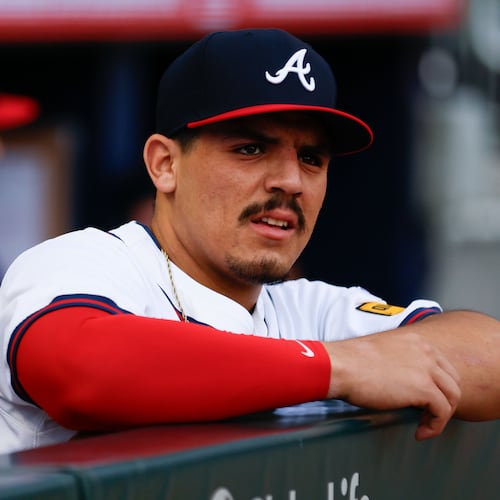When Braves right fielder Ronald Acuña Jr. suffered his season-ending knee injury in a recent game, Atlanta-area sports medicine experts basically shrugged because they’d seen it before.
Acuña suffered a torn anterior cruciate ligament in his left knee May 26 against the Pirates. Acuña previously tore his right ACL in July 2021, ending that season early as well.
Even though few players have had to recover from torn ACLs in both knees, Acuña said his familiarity with the surgery and rehab gives him confidence that he can return.
Doctors The Atlanta Journal-Constitution interviewed agreed. They say the injury is a common one for professionals, but leisure athletes can have it too. Sports that require sudden changes in direction — soccer and tennis for instance — can leave players particularly vulnerable and women might in some cases be more at risk than men, due to anatomical differences, according to Northwestern University and a new study from the University of Memphis.
The ACL is the primary stabilizing ligament that runs through the middle of the knee. It keeps the knee stable during athletic activities, including running, twisting, cutting, and jumping. This stabilizing function protects the cartilage in the knee, decreasing the risk of tears and arthritis.
Dr. Bob DuVall, an orthopaedic and sports physical therapist and director of Sports Medicine of Atlanta, said an injured ACL is reinjured about 5% to 30% of the time. As part of the rehabilitation work following an injury, physical therapists typically work to strengthen a patient’s other nearby joints to put less strain on the knee and prevent a repeat. But that rehab work doesn’t always prevent re-injury.
“A second ACL injury to the opposite knee is less common, at 3 to 11%. That just tells me that we as practitioners didn’t clean up those variables at Acuña’s hip and foot, and perhaps the spine — that those causative factors needed to be addressed.”
Experts said despite Acuña’s two knee injuries, they expect the 26-year-old to recover. But they also note that even hobby athletes need to pay attention to the system of forces bearing down on their joints to avoid knee injuries.
Researchers say ACL and other knee injuries can often be linked to tension and stress in other parts of the body.
One new study from the University of Memphis found that for female athletes, wearing the wrong bra could put a runner at greater risk of a knee injury. It found that wearing more supportive bras could help runners reduce injuries to their ACLs. That’s because when the breast is supported, the pelvis is easier to control, said Douglas W. Powell, a professor at the University of Memphis and one of the study’s authors.
Given that knee injuries are often connected to strains in other areas of the body, DuVall says a key element to most rehab plans post-ACL is strengthening and stretching the hamstrings. “The hamstrings are quite important because they are a secondary stability for the knee,” he said.
Doctors also look at the injured person’s ankle and foot with an eye to reducing knee stress post-rehab. “We want to see if there is a restriction at the hip that torqued the ACL to begin with,” DuVall added.
Once the ACL is torn, it requires reconstruction with a graft from another part of the athlete’s knee. This routine surgery takes 1 to 2 hours to perform and requires a long rehabilitative process, according to Dr. Spero Karas, a sports medicine physician at the Emory Sports Medicine Clinic and associate professor in the Department of Orthopaedics at Emory University School of Medicine. “A full recovery and return to play takes approximately 12 months,” he added.
Karas is optimistic Acuña can return to play, because the Venezuelan native’s track record in bouncing back from injuries has been solid. “Acuña was National League MVP after his right knee (was) reconstructed back in 2021,” Karas noted. “Although it’s difficult to find a ‘silver lining’ for an injury such as this, an ACL injury to the other knee has a better prognosis than a re-tear of the previously injured knee. (Acuña’s) right knee by all accounts is strong and has withstood the challenges of an entire season of MLB play.”
Acuña and his compatriot, former catcher Wilson Ramos, are two of just a handful of players to continue their baseball careers following ACL repairs to both knees. Ramos injured his left knee in 2012 and his right knee in 2016, each time with the Washington Nationals, and then hurt his left knee again in 2021 with the Cleveland Guardians, the AP reported.
When ACL mishaps befall those with multimillion-dollar contracts during live TV, time tends to stop. “The injury is game stopping — literally, play ceases so that doctors can get a look at the state of the knee before swelling obstructs the view,” DuVall said.
Why does the knee swell? DuVall says it’s the body’s way of immobilizing the injury. “Once the knee is swollen, all we do is put an immobilizer brace on so that we can do an MRI, which helps us see if the ACL has been disrupted.”
Acuña will benefit from his own professional trainer’s rehabilitation. “I would expect him to have ... a full recovery and be back playing with the club by the All-Star Break in 2025,” Karas said.
Tips to avoid knee injuries
- Train consistently with a mix of strength and flexibility exercises during the offseason to improve balance and coordination.
- Practice your landing skills and direction changes: Not bending your knees during directional shifts or landings after a jump can increase your chances of an ACL injury.
- Warm up before engaging in activity. Incorporate sport-specific exercise and give yourself time to stretch to prevent muscle strains.
- Strengthen muscles: Focus on strengthening the muscles in your lower body and core. A strong core and hips can help you improve your balance.
Source: Northwestern University
About the Author
Keep Reading
The Latest
Featured



